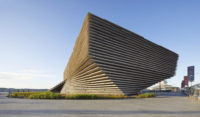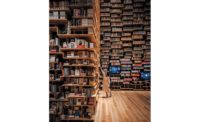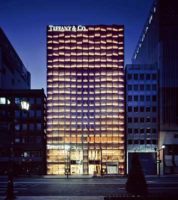Signature buildings by internationally successful architects are often derided as being alien—lacking a relationship to context. Yet the V&A Dundee, which just opened in this Scottish waterfront city, is an affirmation of universal design values. In conceptualizing the museum, Kengo Kuma turned to his cultural heritage. “One of the ideas behind the building is that it is like a torii gate in Japan,” says the architect, “which usually connects a village to the mountains.” Indeed, in a visual sense, the V&A Dundee does act like this element: it is composed of two inverted pyramids that create an archway, framing the adjacent River Tay. As Kuma himself suggests, these volumes share the serrated profile of early Buddhist temples such as those at Hōryū-ji. The museum, which looks a little Japanese, shows how architectural solutions indicative of a specific culture can successfully be reinterpreted in a broader context.
Additional Content:
Jump to credits & specifications
The $100 million project was conceived to continue the mission of the first Victoria and Albert museum, which opened in 1899 in London to celebrate the role of design in modern society. The new building addresses the riverfront of a postindustrial city on the North Sea coast of Scotland in vigorous fashion: poured-concrete walls wrap twin structures, one for public access, the other for administration. From their inclined surfaces, 2,429 precast-concrete panels, into which hooks have been embedded, hang off brackets bolted into channels. Downriver stand the mighty frames of several jack-up oil rigs that were towed here from the North Sea for decommissioning. Kuma’s robust building looks neither small nor slight in comparison.
This is a demanding site in many ways. As project architect Maurizio Mucciola (who initially worked on the project as part of Kuma’s team and completed it as a consultant under the auspices of his own practice, PiM. studio) puts it, the building acknowledges its “very strong marine environment,” exposed to the wind from the North Sea and pounded by the salt water of a tidal estuary. The barrage of elongated, textured-concrete panels with which Kuma meets this—far bolder than his timber buildings in Japan—is a weighty response. Some may despair at the raw appearance of the concrete panels hanging off brackets in a manner that is visible to passersby, but in their slight irregularity they communicate heft and informality.
Often, the analogies made by famous architects between well-known but distant geographic features and new showpiece cultural buildings are trite—Steven Holl’s reference to the Giant’s Causeway in his winning proposal for a gateway to the University of Dublin being a recent example—but here Kuma’s analogy with the cliffs of northeast Scotland is persuasive. Viewed from the far shore, the museum’s striated bands create a gentle visual transition in shades of gray, from the mass of the city beyond down to the water. Up close, the twin volumes are at the same grand scale as the Victorian civic buildings of Dundee, albeit with a more sculptural effect.
The three-story building reacts to its environment in a kinetic sense too, stepping forward and back on each side. It dramatically cantilevers out over the fast-moving Tay to the south and east; presents a vertical facade to the city to the north; and, to the west, curves away from its close neighbor, the RSS Discovery, the ship in which the British explorer Robert Falcon Scott sailed on his doomed voyage to Antarctica. It is “an amphibious, seminautical building,” says Tristram Hunt, director of the V&A London. An initial attempt to place the museum farther out in the river was ultimately rejected, so it now sits within the $1.3 billion publicly funded waterfront-revitalization scheme, 10 times the cost of the V&A itself, making the connection to the city center literal as well as visual.
Inside, the soaring lobby, whose inclined walls are clad in oak panels installed at irregular angles, emphasizes the building’s important role within Dundee. While at first the space seems strangely jumbled, it actually has the effect of creating a certain casualness. Kuma calls the lobby a “room for the city,” and, indeed, it provides a public amenity for an urban center that has lacked one. The largest public building in Dundee is the Caird Hall, a grand Neoclassical concert hall often used for trade shows that is closed most of the time.
Upstairs, the museum has two galleries, separated by a wide foyer. The first, for temporary exhibitions, at almost 12,000 square feet, is the largest in Scotland; the other, the Scottish Design Galleries, houses a permanent exhibit of 200 pieces that outline the history of design in Scotland. These artifacts were largely taken from the V&A collection down in London but have been curated to express the constant and varied international influences on the country’s modern design culture. Key amongst these is the Oak Room, a tearoom interior by Scottish architect Charles Rennie Mackintosh that has been in storage for over 50 years. It is an astonishingly intimate and serene interior and, in its almost sacred simplicity, it comes across as very Japanese.
Kuma remembers first learning about Mackintosh the year he graduated from the University of Tokyo in 1979. “I opened a book of his work, and it made a big impression on me. I couldn’t believe he wasn’t Japanese,” said the architect at the opening of his new museum. Given Mackintosh’s restraint and economy of gesture, it is unsurprising that Kuma borrowed from his work, particularly his furniture—just one more example of how great architects have always sought to engage in cultural discourse, despite huge divides. The building in which Mackintosh’s room stands—outspoken, though comfortable in its exotic character—is another successful example.
CreditsArchitect: Kengo Kuma & Associates — Kengo Kuma, Yuki Ikeguchi, Teppei Fujiwara, partners in charge; Maurizio Mucciola, project architect
Executive architect: James F Stephen Architects
Delivery architect: PiM.studio Architects
Engineering: Arup (structural, maritime, civil, m/e/p/f, acoustic, facade, lighting) |
SpecificationsPrecast concrete Techrete
Curtain wall, Steel-frame windows, Skylights Glass Solutions
Aluminum-frame windows Schüco
Flooring Kingspan, TileCraft, Plyboo
Acoustical ceilings Sto
Elevators Orona |
















Post a comment to this article
Report Abusive Comment